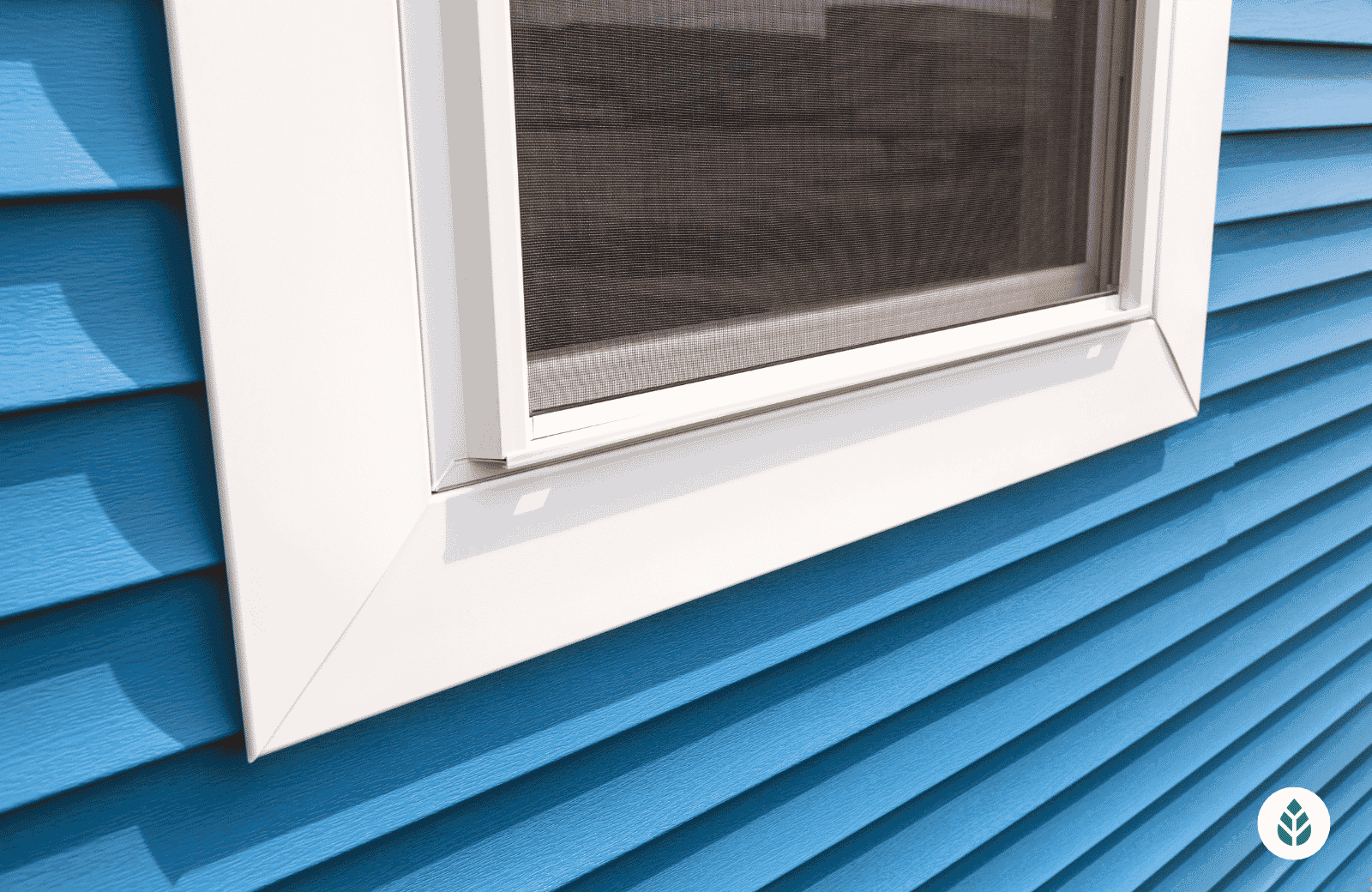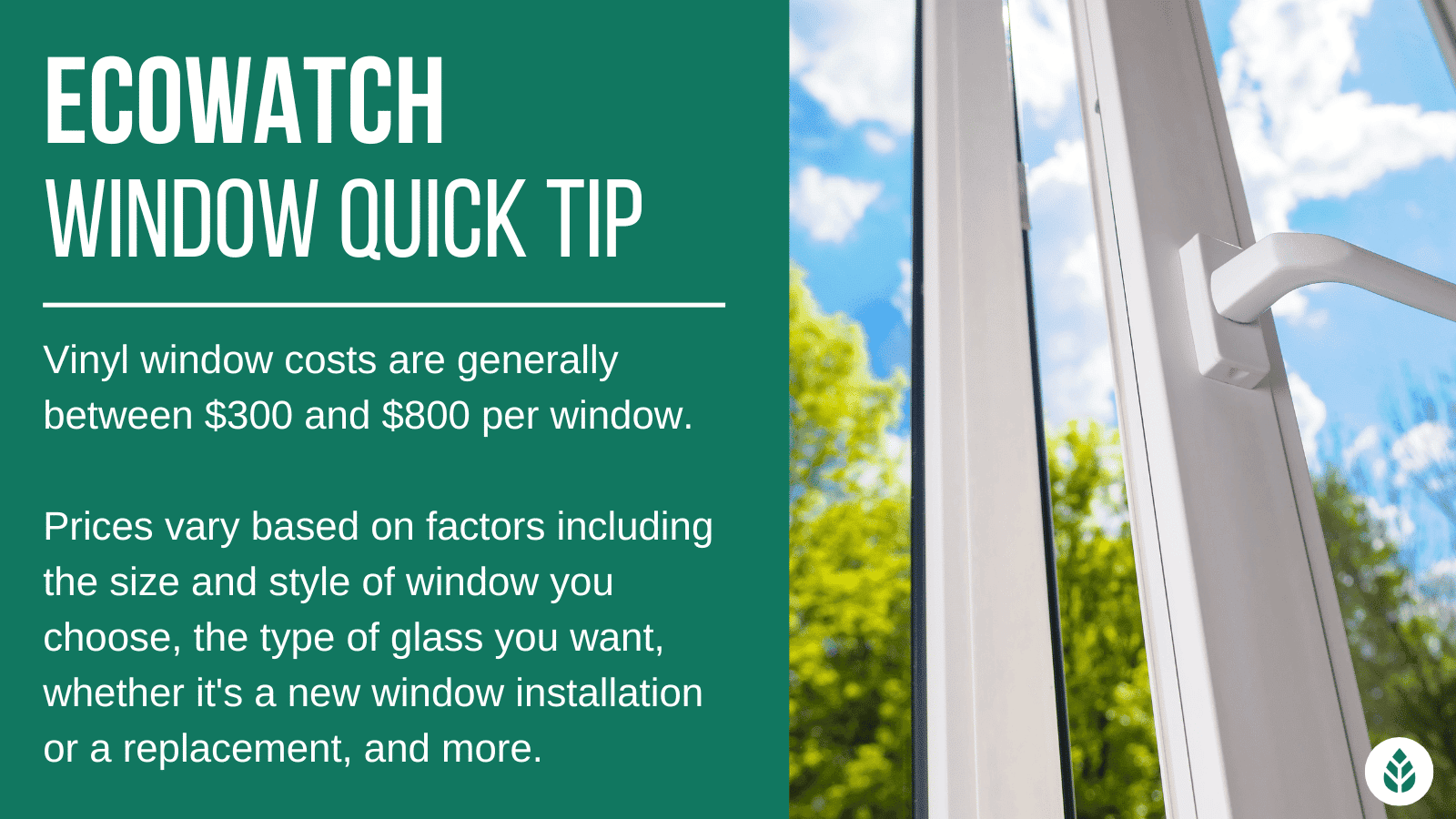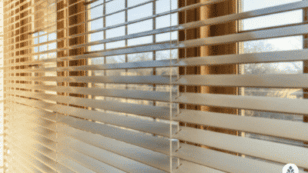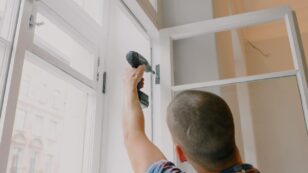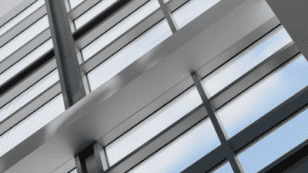
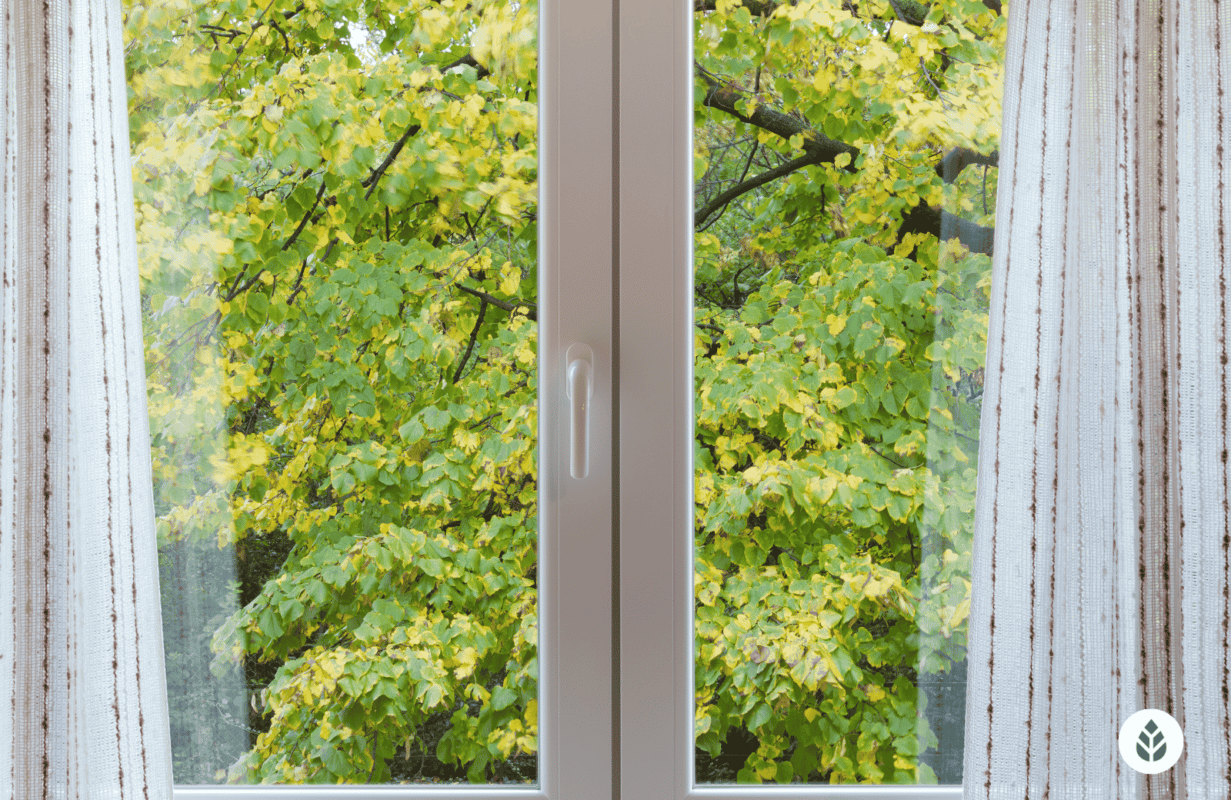
Vinyl Windows Cost 2024: Replacement & Installation Guide
In this complete guide to purchasing vinyl windows, we’ll discuss:
- The national average cost for vinyl window installation is around $600 or between $300 and $800 in most cases
- Why vinyl is considered one of the best window frame materials
- Why vinyl windows are the best option for balancing energy efficiency and cost
Each product and or company featured here has been independently selected by the writer. You can learn more about our review methodology here. If you make a purchase using the links included, we may earn commission.
This article was written with the assistance of AI, but it has been thoroughly edited and verified by an expert human editor to ensure accuracy and quality.
Replacing a vinyl window as a DIY project can be appealing because of the low cost, but opting for a professional replacement is a far better option in most cases. The typical cost to have a professional replace a single vinyl window is around $600, and the total usually falls between $300 and $800 for most windows.
In this guide on replacement vinyl windows, we’ll discuss what vinyl windows are, the pros and cons of this frame material, the cost factors you need to consider when purchasing, and more.
What Are Vinyl Windows?
Vinyl — also called polyvinyl chloride (PVC) — windows use vinyl material for their frames. Frame materials come in a few options besides vinyl, including aluminum, wood, fiberglass, and composite. Vinyl is well-known as the best option for balancing cost and energy efficiency.
Vinyl windows are common in all parts of the home, including living rooms, kitchens, bedrooms, and bathrooms. Even basements can have vinyl windows installed. Some homeowners prefer the traditional appearance of wood windows or other frame materials, but vinyl fits in with most decor styles.

Renewal by Andersen
Pros
- Great industry reputation
- Award-winning company
- Member of US Green Building Council
- Manufactures products in-house
Cons
- No lifetime warranty
- More expensive than competition

Window World
Pros
- EnergyStar Partner
- Large service area
- Wide variety of products and services
- Great industry reputation
- Lifetime warranty
Cons
- Quality of service will depend on your area

Window Nation
Pros
- Award-winning company
- Wide variety of products and services
- Manufactures products in-house
- Custom Designs
Cons
- Installation not covered by warranty
- Limited service area
Benefits of Vinyl Windows
There are a number of upsides associated with choosing vinyl frames over those made of other materials. These include:
- Good insulation: Vinyl is not quite as insulative as more-costly composite or fiberglass, but it provides better energy efficiency than aluminum and wood, especially when you also have storm windows. For most homeowners, new vinyl windows will drastically improve home efficiency and even reduce energy bills.
- Affordability: Vinyl windows are a bit more expensive than aluminum windows, but the price pales in comparison to what you’d pay for wood, composite, or fiberglass frames. Vinyl is considered an affordable frame option that still provides great insulation.
- Availability: Because vinyl offers the best blend of price and energy efficiency, it’s the most widely-used frame material and nearly every window manufacturer and home improvement store — like Home Depot and Lowe’s — will carry it.
- Durability: Vinyl won’t last as long as wood, fiberglass, or composite, but it has overall good durability. The material won’t crack, peel, bend or warp when exposed to changes in temperature, and it won’t expand in response to moisture and humidity, so it resists sticking.
The chart below provides a quick look at how vinyl compares to other frame materials and why it’s a relatively low-maintenance option.
| Aluminum | Vinyl | Wood | Composite | Fiberglass | |
| Resists Cracking | Yes | Yes | No | Yes | Yes |
| Resists Peeling | Yes | Yes | No | Yes | Yes |
| Resists Warping and Bending | Yes | Yes | No | Yes | Yes |
| Resists Sticking in Humid Conditions | No | Yes | Yes | Yes | Yes |
| Can Be Painted | Yes | No | Yes | Yes | Yes |
| Available With Wood Appearance | No | No | Yes | Yes | Yes |
| Considered Efficient (High Energy Star Rating) | No | Yes | Moderately | Yes | Extremely |
| Relative Cost | $ | $$ | $$$ | $$$ | $$$$ |
Drawbacks of Vinyl Windows
As you can see from the chart above, vinyl windows are far from perfect. While they’re relatively durable, affordable, and energy-efficient, they have some downsides, including:
- Not the most energy-conscious option: Vinyl provides decent energy efficiency, but its insulative value is much lower than that of fiberglass and composite window frames.
- Can’t be painted: Unlike other window frame materials, vinyl windows can’t be painted, so you’ll be stuck with the color you choose when you purchase them.
- Modern appearance: Many property owners don’t like the modern appearance of vinyl window frames. Wood is the most sought-after frame material for its classic appearance, and vinyl is one of the few frame materials that can’t be made to look like wood and can’t be made as a wood-clad option.
How Much Are Vinyl Windows, Really?
The standard cost of installing a single vinyl window is around $600. You could be looking at anywhere between $300 and $800, though, depending on the size of the window, the style of the window, the number of windows you replace, the brand you choose, and more. Prices lower than $150 and higher than $1,200 for vinyl windows are uncommon.
Factors affecting Vinyl Window Pricing
The price range for vinyl windows is so wide because there are lots of other factors besides the window frame material that determine the total project cost for window replacement. In some cases, these factors have a greater impact on your window replacement cost than the frame material.
Below, we’ll discuss the major cost factors that can influence your total cost and how each can affect your pricing.
- Style of the window: There are many different styles of windows that you can install, all of which can be vinyl-framed. The type of window you need can push your replacement cost well below or well above the average total of $600.
- Window size: Most windows are priced, at least in part, by how many square feet you need so make sure to have your professional contractor measure or double check yourself and measure the window size yourself. Larger windows will always cost more than smaller ones, provided the other cost factors remain the same. An oversized vinyl window can easily push your replacement total over $1,500.
- Frame material: Of course, the frame material plays a significant role in what it costs to replace your window. Aluminum is the most affordable, with vinyl sitting close behind. Wood and composite are somewhat more expensive, and fiberglass is, by far, the most expensive material option.
- Window construction: The quality of the window construction is an important factor to consider when purchasing a new window. High-end windows often have superior locks and opening mechanisms that will last longer, and some frames are fitted with voids for adding insulation to boost energy efficiency.
- Window brand or series: You can buy similar vinyl windows from two different brands — or model lines — and pay drastically different prices. The difference is usually attributable to the quality of construction, the durability of the window, and the workmanship and manufacturer’s warranty included with the purchase.
- Glass choice and treatments: You can choose to set three different glass types inside of your vinyl frames — single-pane, double-pane, and triple-pane. Single-pane glass is the least insulative but brings your price down significantly. Double-pane glass is a good balance in terms of cost and insulation, and tri-pane glass is expensive but provides the highest level of efficiency and energy savings. Double- and triple-pane windows have sealed layers of argon or krypton gas to maximize insulation.
- Accessories: Vinyl windows can be ordered with numerous options, including more visually appealing or secure locking mechanisms, opening mechanisms, and decorative pieces, like muntins, grilles, and window trim. These can play a role in how expensive your vinyl window is.
- Permit cost: Depending on where you live, you might need to pull a building permit for replacing windows. The permit cost range is usually from $50 up to $200, so this can be a considerable cost addition in some cases.
The cost factors above mostly relate to materials, but a significant portion of your total replacement costs for windows will be for labor. There are a few things that can bring your labor charges up or down as well. We’ll discuss each of these below.
- Window size and shape: The size and shape of your window will affect material costs, but these factors can also have an impact on labor charges. Large windows are bulky and challenging to maneuver during the installation process, so they naturally come with higher labor charges. Additionally, unique window shapes can demand more work during fitting and sealing, and these can push labor charges higher as well.
- New vs. replacement: If you’re installing a vinyl window on new construction, then labor charges will be at a minimum because there is no existing window to remove. Replacing an old window will increase labor charges because there is more work involved.
- Lift requirement: For windows located on a second or higher floor, most window installation companies will use a window lift to pull the window up into place for installation. This means you’ll have to tack on equipment rental, gas and operator costs, all of which can drive up your installation price.
- Stucco repair: Stucco is a popular exterior siding option, but it’s quite fragile and prone to cracking or breaking during the window replacement process. You might need to factor in repair costs for your stucco in case it gets damaged while your window is being lifted into place and installed.
- Seasonality: Replacement for windows naturally costs more in the spring and early summer months simply because the demand is so high then. Most property owners want to avoid opening their walls in the colder months. With high demand comes higher labor charges, so you can expect your window replacement project to cost more in the warmer seasons.
- Geographic location: Lastly, your location matters when calculating your replacement costs for vinyl windows. Labor in more expensive areas will usually be more costly to keep up with the local cost of living, and labor for replacing windows is no exception.
Average Costs of Vinyl Windows by Window Style
The style of window you’re installing is a major determining factor when it comes to price. Certain styles of windows are naturally smaller and simpler than others, which leads to a lower overall price.
In the table below, we’ll include some typical prices for different styles of vinyl windows:
Window Type |
Typical Cost for Replacement (Per Window) |
| Single-Hung Window | $300 |
| Awning Window | $300 |
| Double-Hung Window | $450 |
| Picture Window | $350 |
| Bay Window | $2,200 |
| Bow Window | $5,000 |
| Casement Window | $725 |
| Sliding Window | $750 |
| Skylight Window | $1,000 |
Vinyl Window Prices by Size
As we mentioned above, the size of the window you’re replacing can have a significant impact on your total cost. Not only will larger windows run you more for more materials, but they can also require multiple installation technicians and specialized equipment if the window is particularly heavy or bulky.
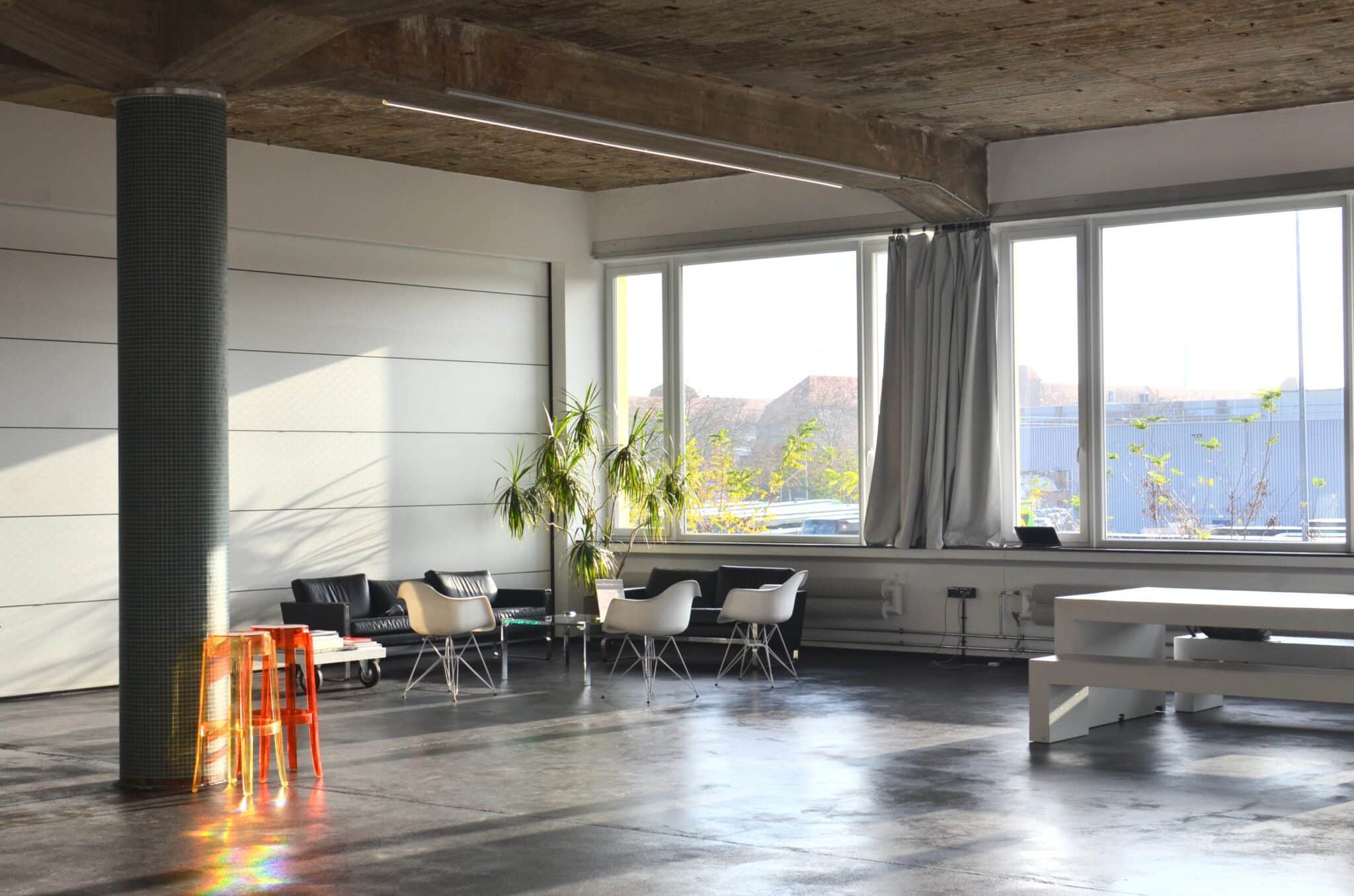
The table below provides a quick look at prices for standard sizes of vinyl windows. Keep in mind that other factors — like the type of window — can still swing these prices up or down even further.
Window Dimensions |
Average Vinyl Replacement Window Price (Per Window) |
| 19” x 16” | $250 |
| 19” x 29” | $300 |
| 24” x 36” | $400 |
| 24” x 52” | $450 |
| 27” x 27” | $400 |
| 32” x 38” | $600 |
| 32” x 62” | $700 |
| 33” x 33” | $550 |
| 36” x 24” | $500 |
| 36” x 36” | $550 |
| 41” x 29” | $550 |
| 48” x 60” | $800 |
| 48” x 72” | $850 |
| 60” x 35” | $750 |
| 72” x 48” | $700 |
| 84” x 48” | $1,000 |
| 96” x 64” | $1,500 |
How to Purchase Vinyl Windows
You have two main options for purchasing vinyl windows for installation. The first is to buy your windows from a home improvement store or retailer like Home Depot, Lowe’s, or Costco. The second is to purchase windows directly from a manufacturer like Pella, Andersen, Simonton, Milgard, or Marvin.
Buying a single window from a retailer or home improvement store will give you the most options when it comes to size, brand, and frame material. However, the cost will usually be higher than the value provided.
Buying windows from a manufacturer will increase the value-to-cost ratio, so you’ll get more for your money. Additionally, you can choose from a wide range of customization options in most cases, as well as glass coatings and glazing options.
Since vinyl is the most common frame option, most manufacturers and retail stores will carry vinyl window options, usually in multiple sizes.
Best Brands and Pricing for Vinyl Windows
We mentioned previously that the quality of the window you choose will be a determining factor when it comes to the price you pay for your new vinyl windows. Two indicators of quality and value are the brand of window you choose and the warranty included by the manufacturer.
Many different window manufacturers make their products available throughout the U.S. These include budget options like Jeld-Wen and Reliabilt as well as higher-end options like Marvin, Simonton, and Milgard.
The table below provides a quick look at the standard cost of vinyl windows from different brand names.
Window Brand Name |
Average Replacement Cost (Per Window) |
| Andersen | $700 |
| Certainteed | $900 |
| Harvey | $900 |
| Hy-Lite | $550 |
| Jeld-Wen | $500 |
| Marvin | $750 |
| Milgard | $800 |
| Pella | $750 |
| Simonton | $750 |
| Reliabilt | $500 |
How to Get the Best Prices on Vinyl Windows
Although vinyl is one of the most affordable frame materials, replacing windows is still an expensive endeavor, and most property owners will want to keep costs as low as possible. Luckily, there are a few things you can do to keep your totals down and find deals on vinyl windows.
First, you can optimize the other window materials and options for affordability. Specifically, you can:
- Choose an affordable glass material: Picking single-pane glass is the most affordable, although most homeowners opt for double-pane windows for increased efficiency in the home. In most people’s opinions, triple-pane glass isn’t worth the added cost.
- Avoid glass coatings: Although low-E applications and window tinting can improve your home’s efficiency and increase energy savings, these treatments also add to your total replacement cost.
- Keep the same window size: If you install a vinyl replacement window that’s a different size than the old one, you’ll be adding on hundreds of dollars in additional labor charges in most cases. Install the same size window to save money.
You can also plan your home window replacement for the off-season. Installation companies are busiest from around April through July, and their labor costs are inflated to keep up with demand. Choosing a late summer or fall installation can help you keep costs down.
Additionally, you can replace all of your windows at once. This will drive up the total up-front cost, but most window installers will provide a small discount on the total project price if you tackle multiple windows at once. This can lead to savings on each window due to labor costs and decreased travel time to your property.
Finally, you can look for deals on vinyl windows, which most often happen around the holidays. Labor day is often a great time for window deals, as it’s after the busy season when window companies want to continue pulling in new business going into the fall and winter.
Calculating Vinyl Windows Budget
A lot of factors go into determining the cost of a replacement vinyl window, so it’s often challenging to calculate an estimated price. Although your results can vary based on seasonality, deals you find, window type, and more, you can use the formulas below to figure out a rough cost estimate:
Cost for a single vinyl window replacement:
Average Frame Cost Based On Window Type + Glass Cost + Labor Costs + Glass Coatings + Window Accessories) x Brand Coefficient = Vinyl Window Replacement Cost
Cost to replace all vinyl windows in a home:
Vinyl Window Replacement Cost (from above) x 0.95 (discount factor) x Number of Windows In Your Home = Discounted Total Price to Replace Multiple Windows
Assuming you’re purchasing a standard vinyl double-hung window with double-pane glass from Marvin and choose no additional glass applications, your calculation could look something like this:
($450 + $100 + $150 + $0 + $0) = $700 x 1.1 = $770 for a single Marvin vinyl window
$450 + $100 + $150 + $0 + $0) = $700 x 1.1 = $770 x 0.95 x 10 windows = $7,315 for 10 Marvin vinyl windows
FAQ: Vinyl Windows
The cost to replace a single vinyl window will depend on many different factors, including the style of the window — like double-hung or casement windows — the size of the window, the window brand, glass coatings, the location of the window in your home, and more. The only way to get an accurate estimate is to have a window company assess your window project and provide a quote.
With that being said, the average window installation cost for a single vinyl window is around $600. Most single windows fall between $300 and $800 for replacement.
Replacing vinyl windows doesn’t take any longer than replacing windows made from most other frame materials — although fiberglass requires some additional time and precision, as the material is rigid and can get damaged by improper installation techniques.
If you’re installing a vinyl window on new construction, the entire process should take around 30 to 45 minutes for a professional to complete. If you need an existing window removed and replaced with a new vinyl window, you should account for one to two hours for the entire process. This could be longer if there are complications, including second-floor installation.
Lastly, you should keep in mind that these timelines don’t account for delivery times. If you’re ordering custom windows or uncommon sizes or styles, you might need to wait several weeks for the materials to be delivered.
New vinyl windows are almost always worth the investment. Vinyl is one of the most popular and prevalent frame materials because it offers a nice balance between affordability and efficiency for your home.
Installing all new vinyl windows will cost several thousand dollars upfront, but your home value is expected to increase as a result, and your energy bills will likely decrease with the boost in efficiency.

 233k
233k  41k
41k  Subscribe
Subscribe 



